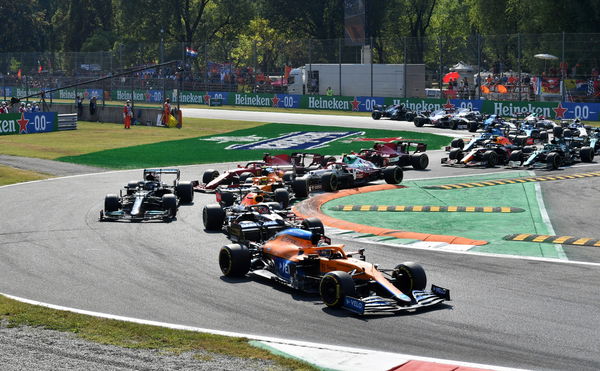
via Reuters
Formula One F1 – Italian Grand Prix – Autodromo Nazionale Monza, Monza, Italy – September 12, 2021 McLaren’s Daniel Ricciardo leads during the race REUTERS/Jennifer Lorenzini

via Reuters
Formula One F1 – Italian Grand Prix – Autodromo Nazionale Monza, Monza, Italy – September 12, 2021 McLaren’s Daniel Ricciardo leads during the race REUTERS/Jennifer Lorenzini
There’s a lot that goes into the art of racing, especially when approaching a corner. We have the late lunges and late braking masterminds on the F1 grid, but what makes them so special? After all, making a corner should be as simple as turning the car, right?
Cornering an F1 car is no easy take. There are a lot of small, quick steps to get it right, with a lot of science backing the act. Getting around a corner faster and ahead of your rival, thus it makes all the difference between a podium appearance, a points finish, and even a victory.
Read more: Michael Schumacher’s Weird Fan Interaction at 2006 Party Proof of His Win-at-All-Costs Mentality
ADVERTISEMENT
Article continues below this ad
Understanding racing lines and forces
While approaching a corner, a driver looks at his racing line, i.e, the imaginary line he should follow to travel around corners quickly. The tighter a corner is, the slower the driver would have to go to exit without losing his grip. By making use of the track, he would try taking a straighter route; braking less and maintaining a higher speed.
However, he would also have to keep in mind the following factors: the brake point, the pivot point [where the car will spin], the apex of the curve, and the exit. Looking at the bigger picture, there are three parts to a corner: the entry, apex, and exit.
The entry is complicated and is where the turning begins. It begins with the acceleration zone, where the driver holds the pedal down to the next part, the braking zone. While braking drivers also have to change gears to slow down just enough to attack the braking point without locking up or losing the balance of the car.
The apex is commonly the center of the turn. Hitting the apex correctly means taking the most linear and, therefore, the fastest way through a corner. After the braking point, drivers reach the turn-in point where they tighten the steering and gradually unwind after making the apex. However, before making the apex, there is also a neutral throttle point where the car remains in a neutral point until after the apex.
Just as important as making the corner is leaving it at great speed. Thus, just as fast as they entered a corner, drivers have to make up for lost time or prepare themselves for the corner ahead of them. All in a matter of seconds.
2⃣
Araca etkiyen kuvvetler:
🏁F: Merkezkaç kuvveti (Mavi Ok)
Merkezkaç kuvveti: Dönme hareketi sırasında arabayı viraj dışına süpüren (sanal) kuvvet.
🏁Fs: Sürtünme kuvveti (Kırmızı Ok)
Sürtünme kuvveti:
Lastiklerle zemin arasındaki sürtünmeyle oluşan kuvvet. pic.twitter.com/VQGwK045xQ
— Fırat Keskin #F1 (@FiratKeskinF1) January 24, 2022
There is also an important science behind attacking a corner. When a car approaches a turn, two forces are acting on it, the centrifugal force that sweeps the car out of the corner; and the frictional force between the tire and the tarmac.
If the frictional force is less than or equal to the centrifugal force, the car makes the corner. However, if the centrifugal is more than the frictional force, the balance is thrown and the car won’t make the corner.
ADVERTISEMENT
Article continues below this ad
The ideal condition to corner an F1 car
Thus, although the approach may be perfect, the car also plays an important role while perfecting a corner. The heavier a car is, its centrifugal force increases. Thus, in high-fuel situations, limiting the friction between the tires and tarmac is important. To do so, fresh soft boots have the least drag when reaching a corner; therefore, the car remains quick while heavy.

via Reuters
Formula One F1- Saudi Arabian Grand Prix – Jeddah Corniche Circuit, Jeddah, Saudi Arabia – December 5, 2021 Mercedes’ Valtteri Bottas in action with Red Bull’s Max Verstappen during the race REUTERS/Ahmed Yosri
So, the highest cornering speeds are dialed in when the cars are low on fuel, suited up with the soft compound tires. We see this only on Saturday’s qualifying sessions. On Sunday, the car can’t be in this ideal scenario. The car can’t achieve high speeds on the corner compared to its qualifying times because it’s full of fuel, with harder tire compounds.
ADVERTISEMENT
Article continues below this ad
Watch this story: Verstappen the Big Winner as Hamilton Loses Out at Turkish F1 Grand Prix
ADVERTISEMENT
ADVERTISEMENT
ADVERTISEMENT
ADVERTISEMENT

